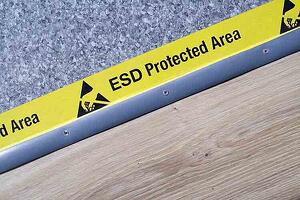CO Spotlight: What is ESD and What Does it Mean for Me?
 Think back to childhood. It is winter and the air is crisp and dry. You put on your thick wool socks, and with all your might, rub your feet back and forth across carpeting in your parents’ living room. You reach out with one tingling finger and ZAP your intended victim on the shoulder. Ouch.
Think back to childhood. It is winter and the air is crisp and dry. You put on your thick wool socks, and with all your might, rub your feet back and forth across carpeting in your parents’ living room. You reach out with one tingling finger and ZAP your intended victim on the shoulder. Ouch.
That zap and little arc of energy you may have observed shooting out of your extended finger is electrostatic discharge—ESD. It is the same force that makes your hair stand on end when you rub a balloon over your head, and the same little shock that can, if a company is not careful, render large amounts of Central Office (CO) equipment completely "defective."
How can this seemingly harmless spark cost a company tens of thousands of dollars in equipment costs? Two ways.
Telco plug-ins, computer equipment and other sensitive circuitry used and housed in a Central Office can be quickly damaged by the sudden, intense flow of electricity caused by a static charge, rendering it non-operational. Connectedly, during inventory, many organizations consider equipment that is “improperly stored”—i.e. stacked too closely together or stored in a variety of ways that could make an asset susceptible to a static discharge—to automatically be “defective.” During a thorough inventory, equipment is then considered damaged, and may be discarded or shipped back to a company’s central warehouse, causing the organization losses.
According to Quality Assurance pro Suzanne Knott with Alden, “In one project we worked on this year, we found piles and piles of plug-in equipment that the company thought they were using as spares, but our directive was that if they were stored improperly, they were considered defective. We sent back thousands of plugs that were considered defective simply because they were not stored properly." “Some of the larger blades can cost $20,000 - $40,000 a piece to replace. That is a lot of money.”
Eliminating Electrostatic Discharge
We will spend some time discussing specific solutions to mitigating the risk of this kind of damage in future blogs, but in general, there are a few precautions a company can take to stop ESD in its tracks.
ESD wrist-straps are readily, commercially available and should be issued to employees who may come in contact with in-use or spare, stored equipment. These small, fabric bracelets safely ground a person working on sensitive equipment like plugs and blades to prevent the buildup of static electricity on his or her body as well as its discharge.
ESD gloves work similarly, and are generally made of anti-static materials such as polyester and nylon, and protect both the worker and environment from static discharge. These gloves are also effective in keeping oils from the skin from damaging plugs and other equipment.
Beyond simple equipment-based safety measures, the most effective way to prevent electrostatic discharge in the Central Office environment is to properly outfit the building itself and store equipment properly. We will tackle a few tips for creating an optimal, ESD-free CO in a coming blog. Stay tuned, and stay alert about the potential problems caused by static, lest your company be in for the financial shock of a lifetime.

Comments